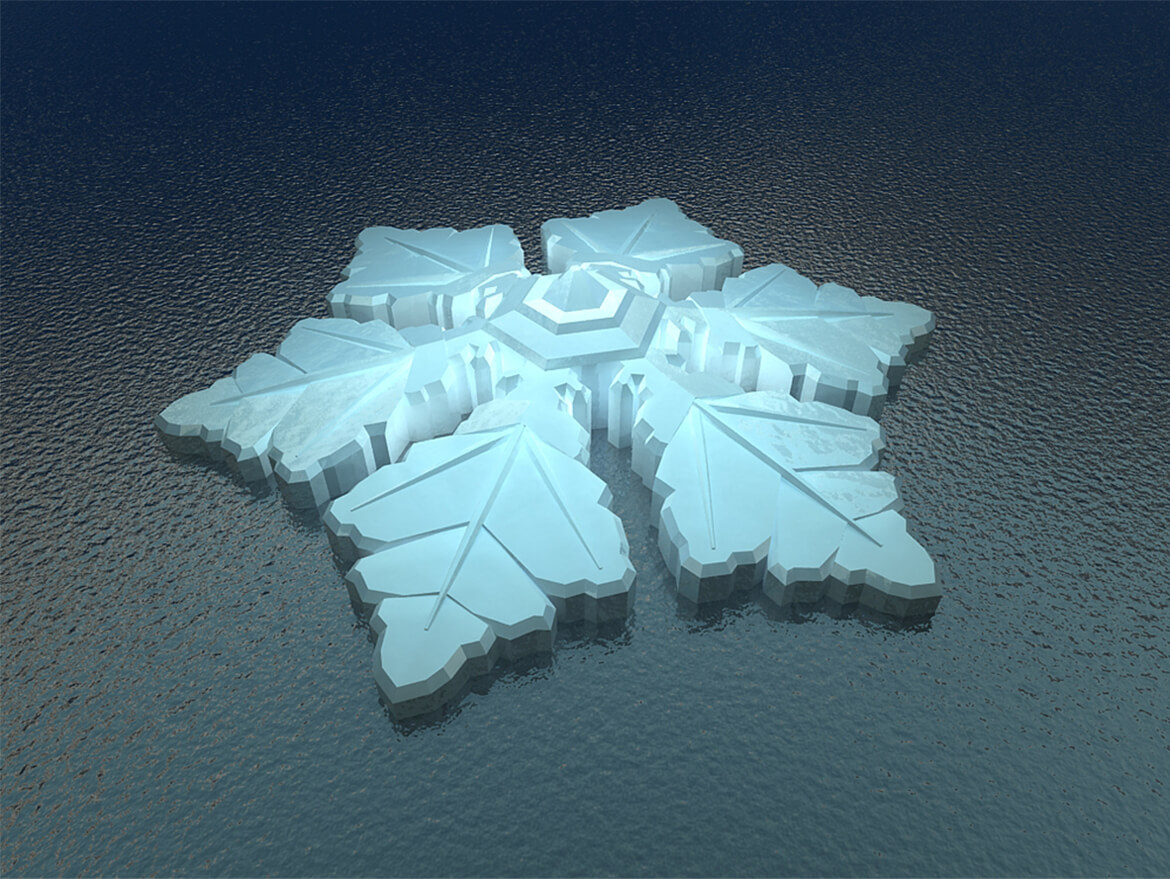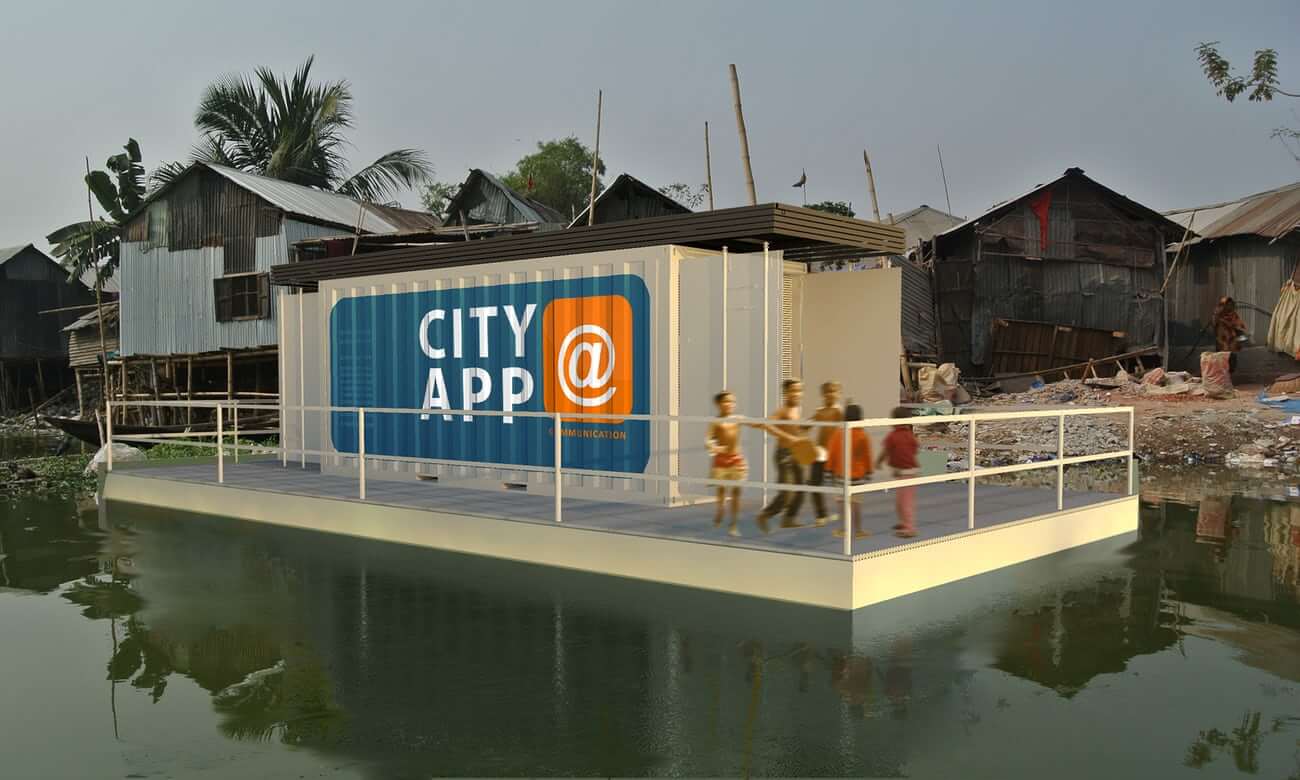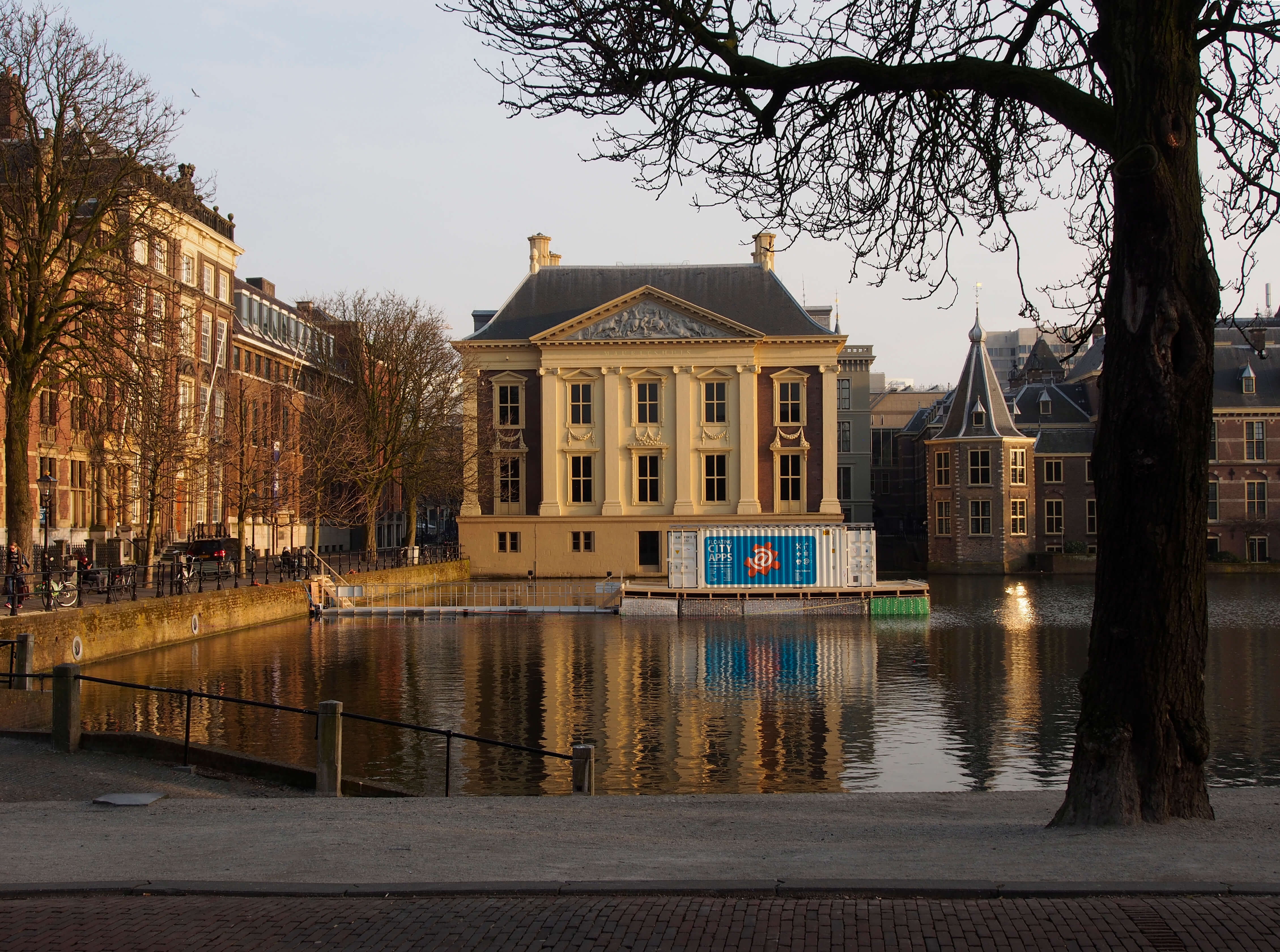
Oceans of opportunity
CLADmag
from Cladbook2017
Issue 3.2016
PhotoCredits: Waterstudio
Koen Olthuis has been touting the benefits of floating cities for years – and now people are starting to take notice
A number of high-profile projects have recently brought attention to Koen Olthuis’s approach to living on water. Those include the floating Citadel apartment block in the Netherlands and important large-scale leisure projects such as luxury private islands in Dubai, floating hotels and resorts in the Maldives and a snowflake-shaped hotel off Norway. The potential for floating architecture, Olthuis says, goes far beyond one-off developments: it’s an urban planning tool.
“For the past 15 years, I’ve been designing these floating structures,” says Olthuis, who established his design firm Waterstudio in 2003. “When I started, all the other architects thought I was crazy, but now this approach is starting to be adopted by developers. We’re also talking to governments around the world about how floating developments can upgrade and improve their cities.” The big picture in all this, according to Olthuis, is that extending cities beyond the waterfront and indeed further out to sea reduces the pressure on overpopulated urban areas – where 70 per cent of people will live by 2050 – and offers flexible solutions for problems thrown up by rising sea levels and climate change.
How do floating structures work at a city level?
Governments worldwide are looking at how floating developments can improve their cities. I propose a system of modular floating developments – floating urban components that add a particular function to the existing grid of a city. With this system, any question a city asks can be answered immediately. If a city needs parking, bring in floating parking. If it has green issues, bring in floating parks and Sea Trees [Waterstudio’s offshore green structures]. The system is responsive to the needs of dynamic urban communities.
Is floating architecture the way forward for urban living?
It’s project to product. You’ll be able to order buildings in, and sell or lease buildings you don’t want or need. We’ve only explored a fraction of the possibilities, but in the next 10 to 15 years, more and more architecture will start to explore the possibilities of floating developments and it will grow from something that’s a fringe architecture to something that’s mainstream. The stupid thing is that we live in dynamic communities and yet we build static structures. With rapidly changing social structures and technologies, we need flexible cities. I’m not saying we have to build floating cities, but that every city that is next to the water should have at least 5 per cent of its buildings on the water. That would create flexibility.
It’s not the only way, but it’s something that is inevitable. It’s about rethinking and finding solutions for major problems.
What other advantages are there?
We believe green is good but blue is better. Water provides many tools to make more durable and sustainable cities. You have water cooling for the buildings, you have flexibility, you have buildings that rise and fall with the water level, you don’t have to demolish a building that’s no longer needed because you can repurpose it or even sell it. People, developers and politicians are starting to see that this is something that brings in money and solves problems. It’s a feasible way to build better cities.
What do you mean by flexibility?
I don’t mean that you’ll be able to take your house and move to another city or another neighbourhood. I mean flexibility on a larger scale, where cities and urban planners are able to move a complete neighbourhood half a mile or bring in temporary floating functions – like stadiums – and use them for one or two years before they leave for another city. This large-scale flexibility makes sense. Take the Olympic Games. It’s so strange that every four years we build so many hotels and stadiums and only use them for a few weeks. Imagine if as a city you could just lease these floating functions from a developer. Cities who don’t have as much money as London or Rio or Beijing could also host these types of events because it would cost much less money.
Is it something you can foresee happening in the near future ?
Yes, maybe not with stadiums – because we can put them up easily – but with the hotel business, certainly. Qatar has the World Cup in 2022 and they need 35,000 hotel rooms for that event. But if they built 35,000 hotel rooms, within 10 years they’d be empty. So they’re thinking about using cruise ships. As the harbour facility is not big enough, they’re also thinking about the idea of fl oating harbours, or fl oating cruise terminals – something that can facilitate these cruise ships for a few weeks, and then a: er that you can bring the fl oating harbours to another location.
Can you tell us about Amillarah Private Islands?
Yes. With OQYANA Real Estate Company and developers Dutch Docklands, 33 private islands are being built as part of The World Islands project in Dubai. The islands are being sold by Christie’s International Real Estate, with a starting price of US$10m. It’s a really high-end project. The fl oating islands look like tropical islands covered in trees, but in fact they’re more like superyachts. They’re built in Holland and then moved to the location in Dubai and anchored there. They are self-su5cient with their own electricity and their own water. Within the next 10 years there’ll be more development around them, so we’re making it look like its own archipelago. If you fly over, it looks like a series of green islands. OQYANA has a masterplan around Amillarah that includes shops, hotels and all kinds of leisure architecture. This is just the first step of the development, but the beauty of this floating architecture is that it moves very fast. Once you’ve built the islands you can just tow them in and connect them to the boKom, either with cables or telescopic piles and they’re ready. Compare that to the manmade islands at The World. There’s still very liKle built there. It’s di5cult to get labour there, di5cult to build the right foundations and there’s no electricity or water, so developers don’t know how to build there without losing money.
Have any been sold?
Not yet. We’ll have an island there, like a show home, from December this year (2016). With the history of the property market in Dubai, it’s beKer to have the first islands there so people can have a look and understand what it’s all about, especially at the prices people pay in this type of market. I should add that if I only ever build floating islands for the rich then I’m doing something wrong. The start of this story for me was to create a new tool for cities that are facing urbanisation, overpopulation and climate change – and also for cities that need to brand themselves to aKract inhabitants. As well as being able to answer these big, fast-changing urban problems, these floating structures bring a certain character and appeal to a city – a USP.
Why does your concept appeal to resort or hotel developers?
On water, leisure architecture, including resorts and hotels, has the possibility to change. You can adapt and create functions that are not only moveable but also transformative through time, for instance, through the seasons. With seasonal structures you can open up the buildings in the summer, make buildings more dense or more spread out. You can add functions or take them away. To me, it’s one big playing field and we’re trying to work out what it means for the future of leisure architecture and real estate, not just how these things will look, but the economic eUects too.
What kind of economic benefits might there be?
A project we started working on a few years ago was a floating hotel and conference centre for the Maldives – the Greenstar. As well as answering fast-changing urban problems, floating structures bring a certain character to a city – a USP The star-shaped hotel has five legs, each with 80 rooms inside, but instead of building five legs, we build six. One of these legs will stay in a harbour in India. In five or seven years time, when the hotel needs refurbishing, you bring the sixth leg to the hotel and connect it, sending the others one by one to be renovated. The hotel doesn’t need to shut down, and the work can be carried out where it’s easy and cost-eBective to get the materials and labour to do it.
What other projects are you working on?
We’re working in the Middle East, in Abu Dhabi, Dubai and Oman, exploring the potential of ecotourism. We’re looking at building satellite resorts for land-sited hotels, that float out at sea where there are coral reefs or mangroves. Floating resorts don’t leave any scars on the environment – they’re scarless developments, which can even have a positive eBect on the environment. For example, we work with marine engineers and environmentalists to help build floating structures that aKract underwater life. In places like Dubai, it’s so hot that it’s very
diLcult to create the right environment for fish and marine life, but the shade of these floating islands can provide a starting point for new marine ecosystems. We’re also working with master developer Dutch Docklands and the Maldivean government on the ongoing Five Lagoons Ocean Flower resort and residences. Finally, we’re looking at developing cities that face troubles with the environment, density and infrastructure – and seeing how water can be part of that solution.
What are the challenges?
Progress on Norway’s Krystall Hotel is slow because of laws that prevent building on the shoreline. Regulations and laws can be a hurdle, and may need to be changed to adapt to floating architecture. But, we are slowly moving to a marketplace where these floating developments are accepted. There’s a bright future for this technology.
Slum Schools
Waterstudio has been pioneering the concept of floating facilities that can be moored at waterside slum communities anywhere in the world. City Apps are floating developments based on a standard sea-freight container. City Apps can be established in water where there is scarcity of space and can be used to upgrade sanitation, housing and communication installations. The first City App, a floating school, is being built for a slum in Dhaka. “One billion people live in slums worldwide and half of them are close to the water. We can use City Apps to instantly improve the quality of life there,” says Olthuis. Because governments see these as temporary solutions, it’s much easier to get permission to do this than to build a facility on land.


Click here for the full article


